In football, the ball is everything. The on-ball security is the first thing coaches try to teach their players if they base their football philosophy on possession or somewhat of pass-game domination. If you have players that are comfortable in every position around the pitch, no matter how tough the pressure is that is coming from the opposition, then you have a great basis for a progressive passing play.
The players like Sergio Busquets, Moussa Dembele and Frenkie de Jong, who came after legendary players like Xavi, Andres Iniesta and Andrea Pirlo (and many more) perfected that segment of the game, and now are the role models for generations to come. Plenty of coaches build their gameplans exactly on the fact their players feel comfortable in small spaces, protecting the ball at all costs with panicking excluded from the equation.
That being said, individual possession is the main reason why most of the tactics we love and used to love in the past are and were successful. Pep Guardiola’s initial ‘tiki-taka’, Jupp Heynckes’ Bayern Munich from the 2012/13 season, Johan Cruyff’s Barcelona, Quique Setien’s life’s work, and Marcelo Bielsa’s whole footballing idea are all concepts on the foundation of individual possession coaching.
For that matter, this coaching tactical analysis will show you the four drills that will help you train the individual possession and bring your players’ on-ball security to a higher level.
Overview
The term of individual possession is a quite simple one with, a lot of complex factors that influence it throughout the game. It includes all the actions and motions players perform while receiving, protecting and passing the ball, helping their team’s action progress or stopping the opposition win the ball.
Of course, individual possession is just a part of a way bigger picture, but it needs to be worked on as it is the basis for the ground play, and retaining of the ball in general. The idea of having technically gifted players who are great on the ball gives your team the possibility to control the action on the pitch and to always be one step ahead of the rival by pulling the strings of happening.
In order to do so, training is the best method that will bring your team to play it that way, so this analysis will break down the exercises that you could use to help your players become more sure when they have the ball in their feet. Also, it could help them become braver when pressurized since the main coaching points in those drills are related to retaining the ball under pressure and keeping it in difficult situations.
1v1 and 1v2 progressions
The first exercise we are going to talk about is the two-way session that has a goal to make your players more press-resistant. This drill has the most simple setup of them all, since there (at first) are just two players in a 7-10×7-10 meter square, with two players outside on the opposite sides.
Like the setup, the task is also quite simple – one of the players gets the ball with his back turned to the opposition, and needs to find the way to pass the ball to the outside player on the opposite side. Coaches need to encourage their players to create space for themselves as fast as possible, and to pass the ball quickly. After the successful pass, the player that was in possession gets the ball once again and repeats the task, with successful passes counting as points.
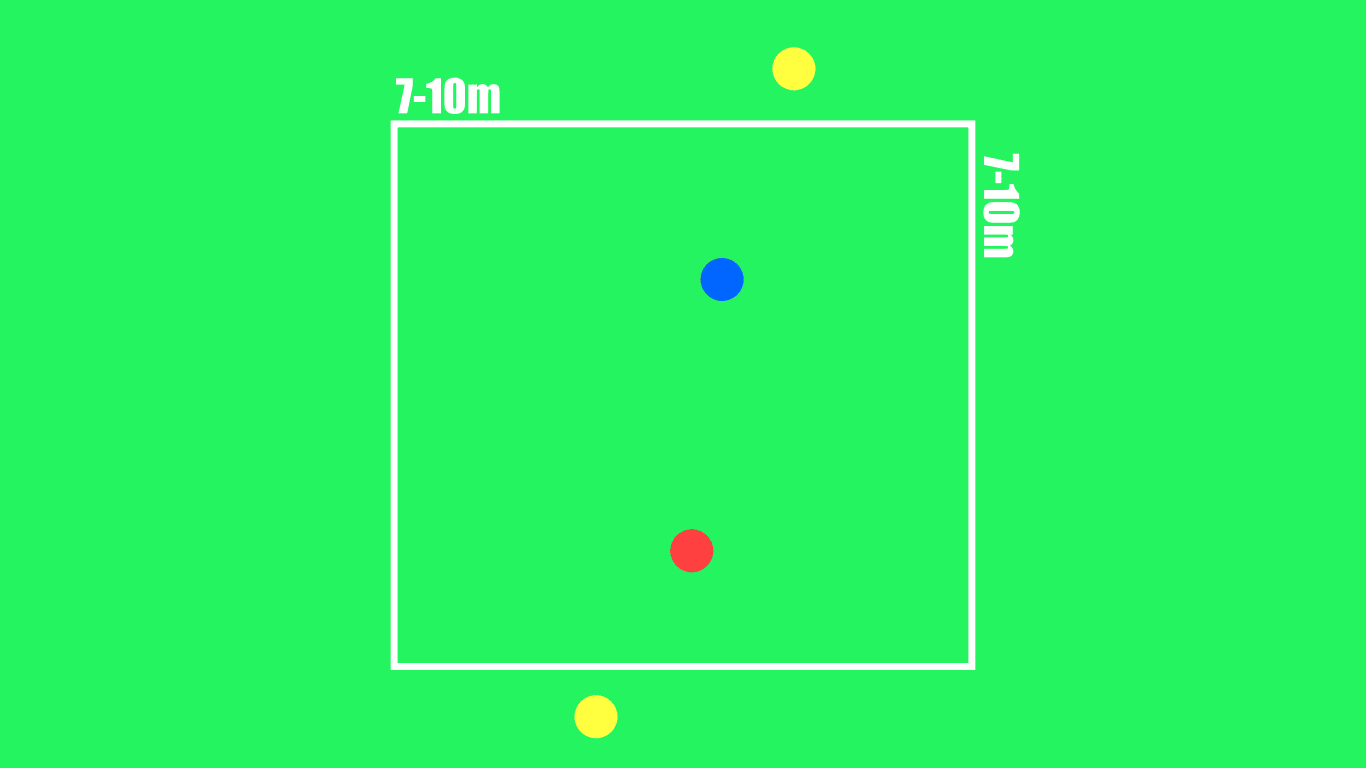
Let’s rewind a bit, and start from the scraps. This is the initial setting of the players inside and outside the box, with Red being the player who will initially get the ball. The defender is encouraged to press the player from behind the second the ball is passed to him, making the pressure very intense and leaving the player with the ball with as little time as possible for positioning and decision-making.
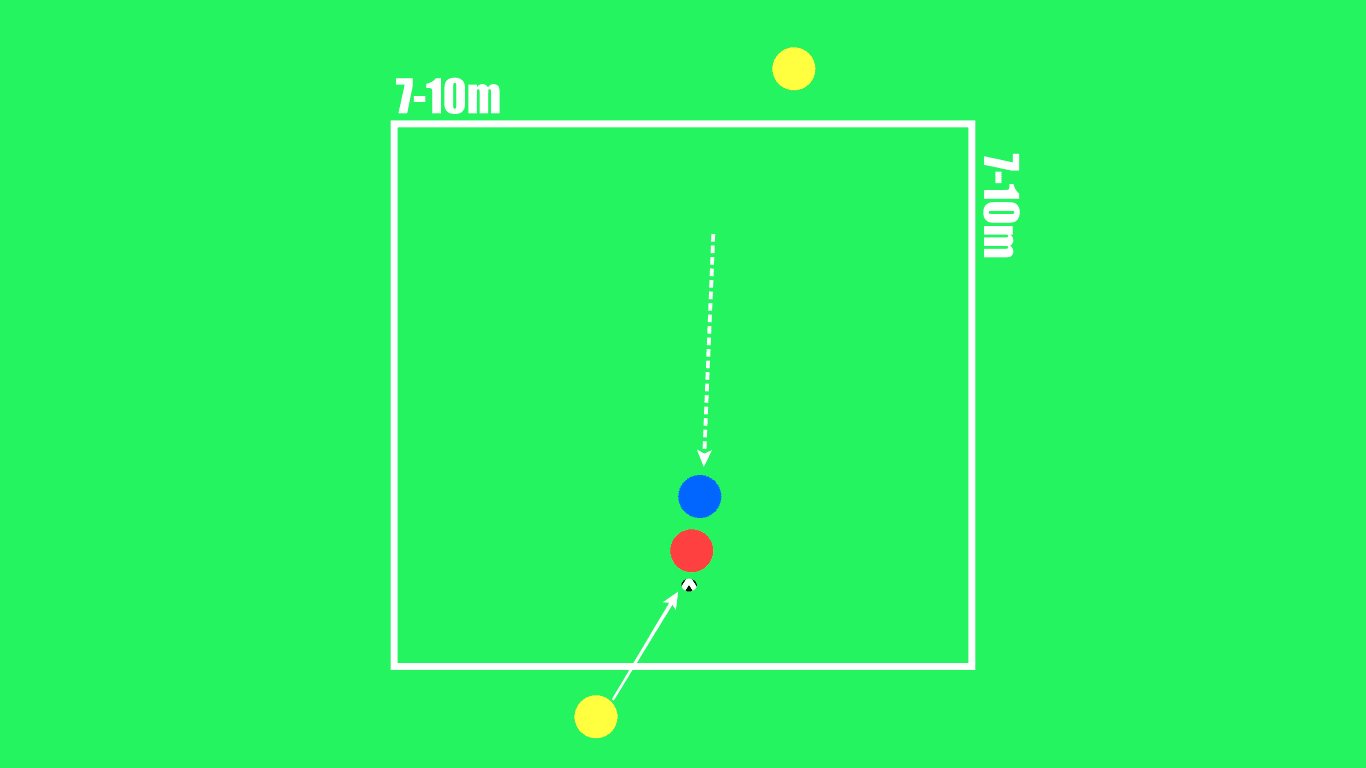
When Blue wins the possession, the tables switch, and he’s now in the role of the attacker, with the exact same task to perform. The drill can be modified throughout the session with key modifications being related to the time player have to pass the ball to the side player, for eg. Red player has 15 seconds to progress the action, if he doesn’t succeed, Blue gets the ball and needs to do the same in the time-gap. Also, another modification is for you to encourage players not to pass the ball to the players outside the box, but just to keep the possession under high-intense pressure for the exact amount of seconds (20, 30, 40, etc.).
This drill commonly transforms into the 1v2 game, with the same approach and tasks, but with a higher level of difficulty that player in possession needs to face. Now, he’s playing against two defenders and needs to orient his motions in order to create the small space that will help him pass the ball towards the bounce player.
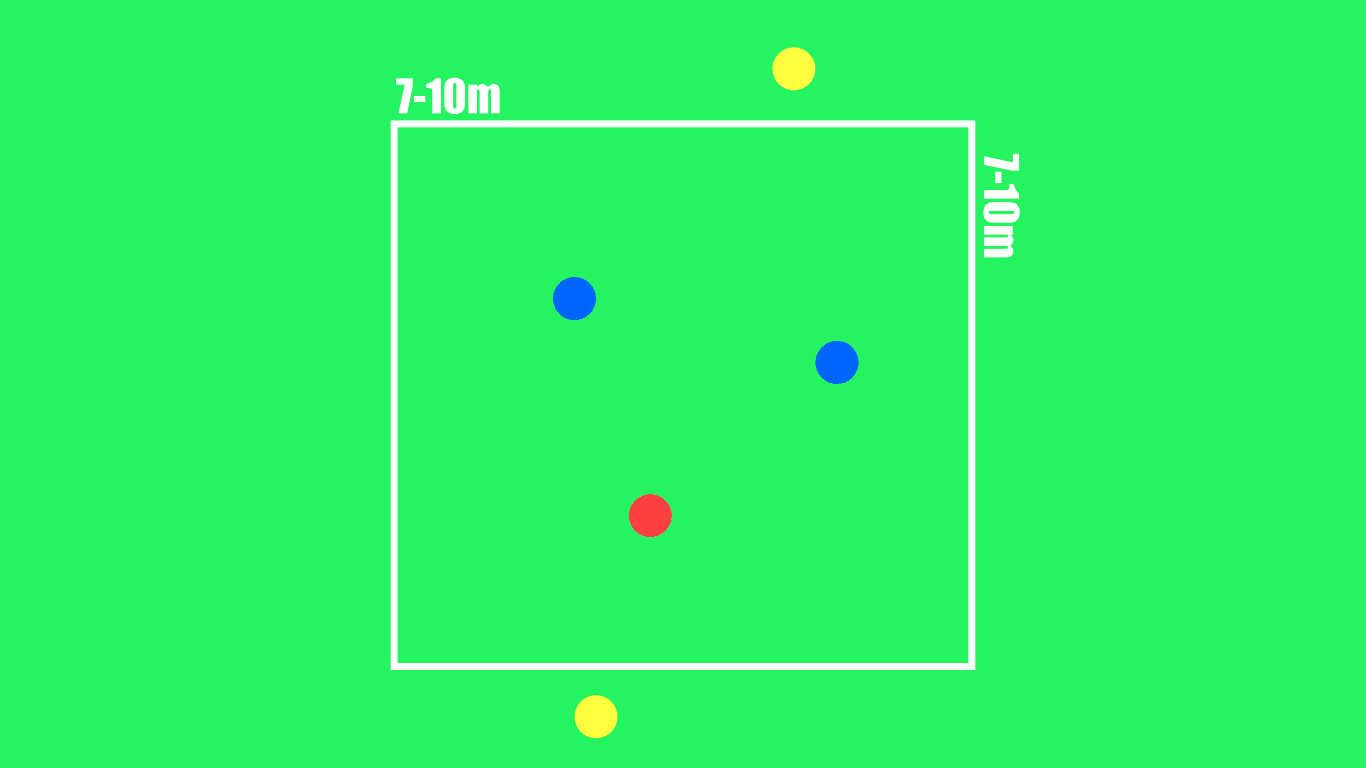
Coaching points for this setup are: firstly – to encourage the attacker orient his body in the best possible way to receive the ball and enable himself to progress it further, but also not to lose it, and secondly – to organize the two-men defence, build up the communication and make them find the balance between pressing and back covering. Also, defenders need to press the player with high intensity in order to cut him possible options and win the ball in a numerical surplus situation.
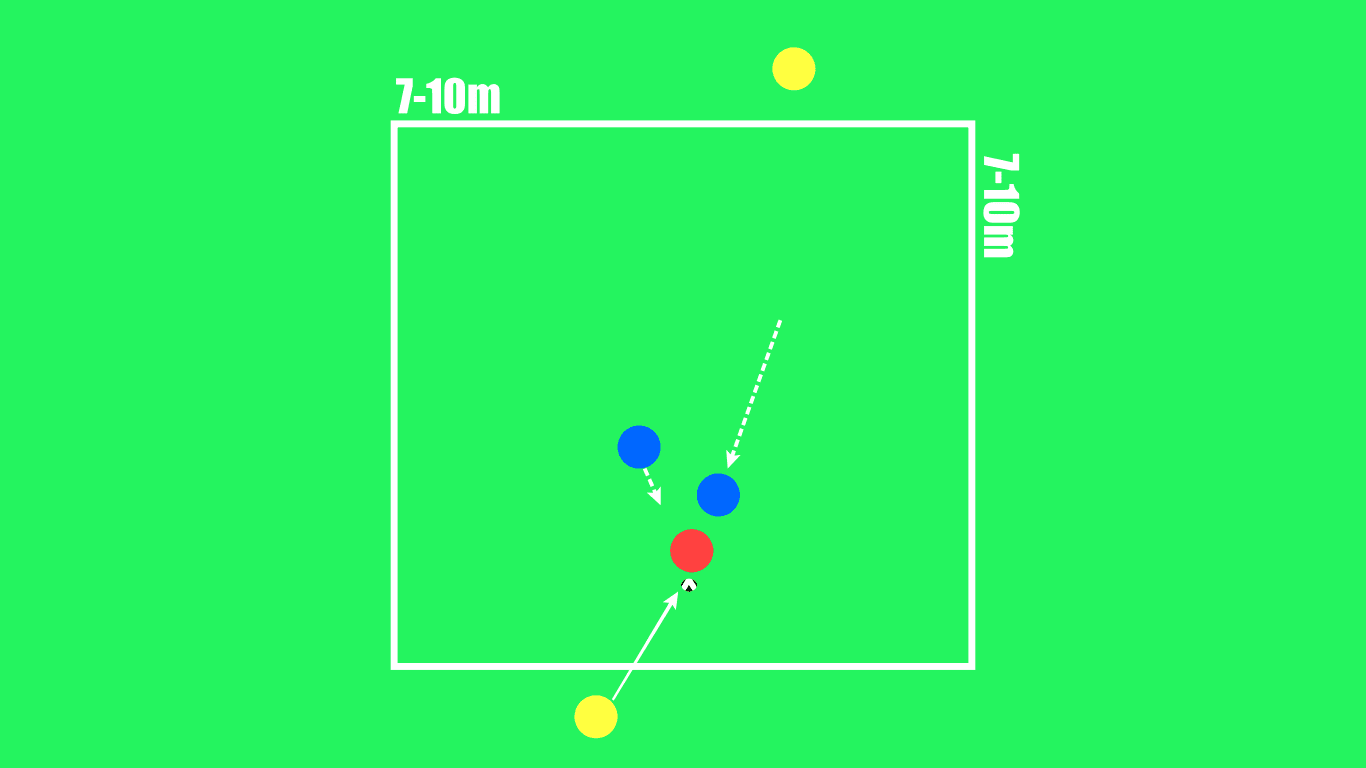
As it is shown above, both players need to come at the player with the ball, attacking him from behind and forcing him to break under pressure, whilst the attacker is once again encouraged to find the quick solution in through the two of them which will enable his team’s progress. When the two defenders win the ball, they need to progress towards the opposite line in order to get the point, with the attacker trying to stop them. In order to be fair, if the red player succeeds in finding the outside player, he’s awarded two points, while the Blues get one point each time they beat him after winning the possession.
This drill, with both of the modifications, accustoms your players to operate in the small spaces and forces them to think before passing the ball. Also, it makes them improve their vision along with the on-ball security so it can provide a huge leap forward to possessional-based sides.
In terms of defence, it trains your side to communicate when out of possession, and builds up individual aggression of your players, orienting their minds also to the counter-pressing game (with pressing after they lose the ball).
1v1 dribbling game
The next exercise we will show you in this analysis is one more that is quite simple on the first sight, but it builds up to players’ abilities in a lot of different levels. The drill is taking place in the 6-8×20-25 meter rectangle with two players inside it, and two players outside, on the longer sides of the box (those two players are optional, they don’t need to be neutral players, as you can go there with players waiting for their turn to participate in the box).
Two players are supposed to play 1v1 dribbling game, with the ultimate task of dribbling through the gate on the opposite side. Points are counted and game can be played in a competitive manner since you can line up two teams on both ends of the area. It is recommended that two players play the game as long as one of them dribbles through the goal, after which the other two players step in to do the same.
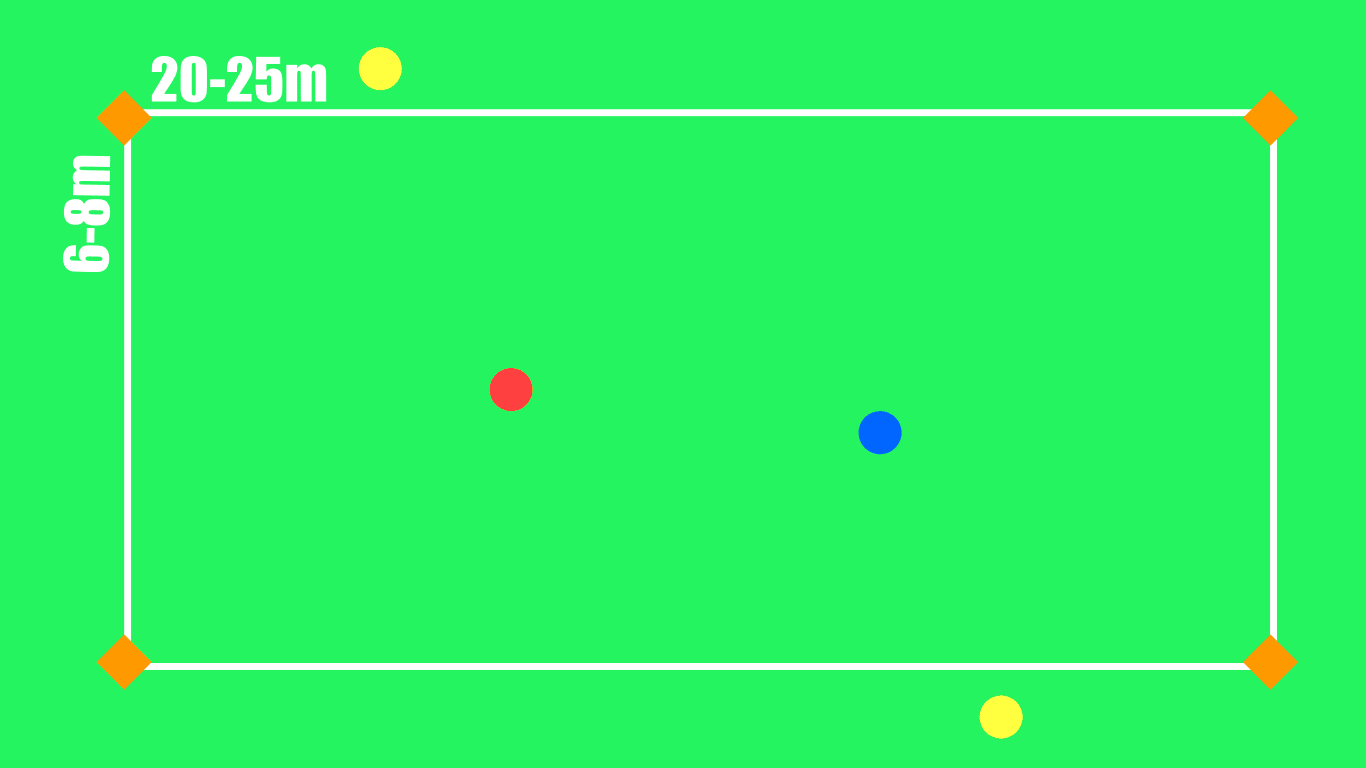
The drill starts with the pass from the player outside the box and it is important for the attacker to position his body correctly in order to receive the ball with in order to create a good position for himself. The defender is asked to be aggressive, but also to decide by himself will he press from the start or will he wait for the player to come closer and play it steadily.
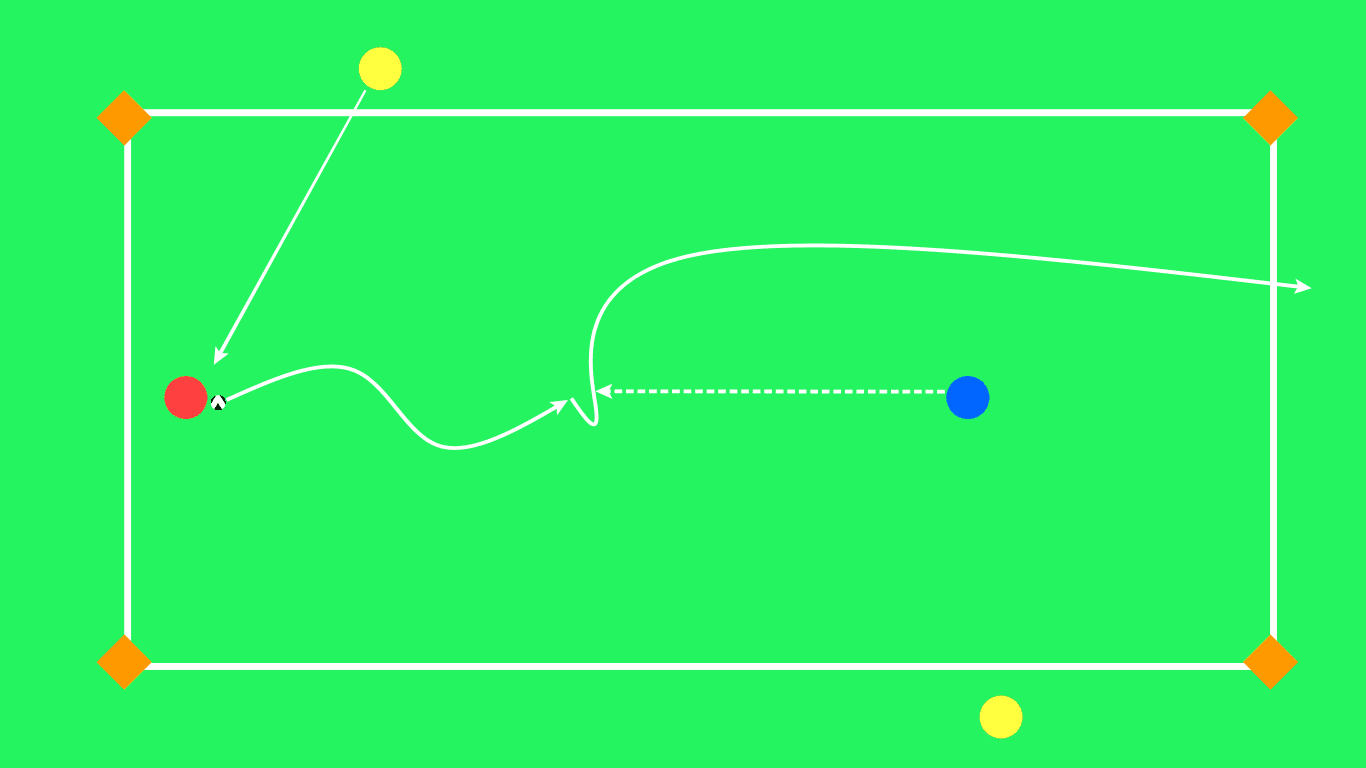
The variations to this exercise happen in terms of from where comes the ball to the attacker, so he’ll in one modification need to receive it with his back faced opposition, and also you can ask a defender to stay closer and press from the moment of ball-reception making it his task. When the defender wins the ball, roles switch, and he has the same goal in front of himself – to get the better of the opponent and dribble between the two orange cones on the opposite side.
This drill looks like it is an easy one, mostly because it doesn’t include much tools and its field of action is quite simple, but the fact that the box is very narrow (it is recommended to go with the six-meter width) means that the player with the ball can’t rely on the space and needs to find the solution by himself if he wants to pass the defender. Also, it brings up to light the defensive 1v1 game, both coaching the aggression and the steadiness, controlling the opponent’s movements and helping your defenders become more comfortable in those situations.
Players can’t escape pressing and not-comfortable setups due to the ground dimensions, and that will teach them to become more secure in themselves, building their self-esteem as much as their on-ball skills.
Through the gates dribbling + defending
The third exercise that can help you develop your players’ individual skills is the mixture of decision-dribbling and extorted counter-pressing. The setup for this drill is a little bit complex than it was for the previous two, but still quite simple as is consisted of the two merged 12×12-15 meter boxes with the two goals settled on the half-way line of the field.
The number of players included in the game depends on the number of players you have in practice, and it is recommended to play it in a two-team manner, so it gets more competitive. Either way, only two players are always in the box participating, whilst teams are lined up waiting for their turn on the opposite sides of the full area.
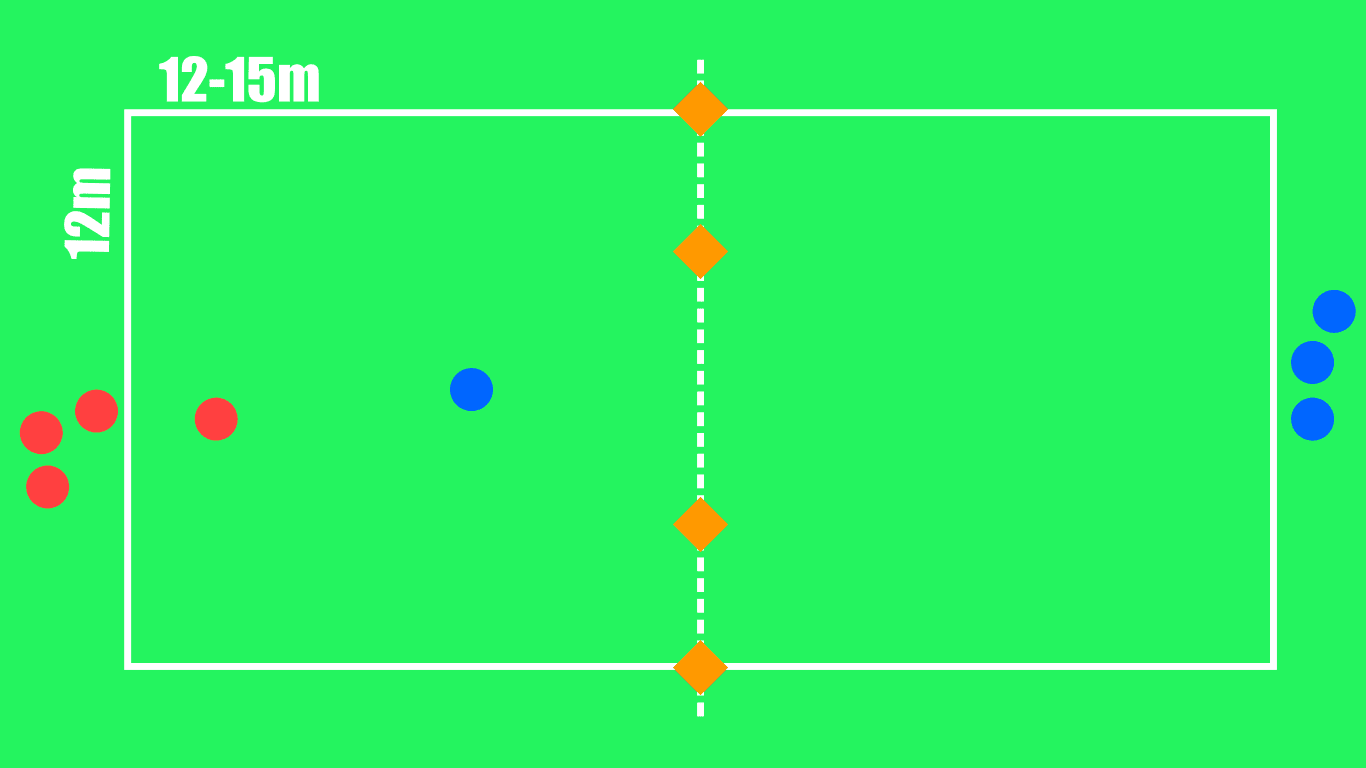
Here we can see how the setup needs to look like at the beginning of the drill, with Red in the possession and Blue defending. The task for the player with the ball is to dribble his opponent and to go through one of the two gates at the half-way line. The main coaching when it comes to the attacking part of the drill is to ask the players to make decisions by themselves, and to make them in a short period. The field isn’t that big, so they need to get to know how to operate in the tight areas under pressure, in the situations where they are facing towards an opponent, so they need to move quickly.
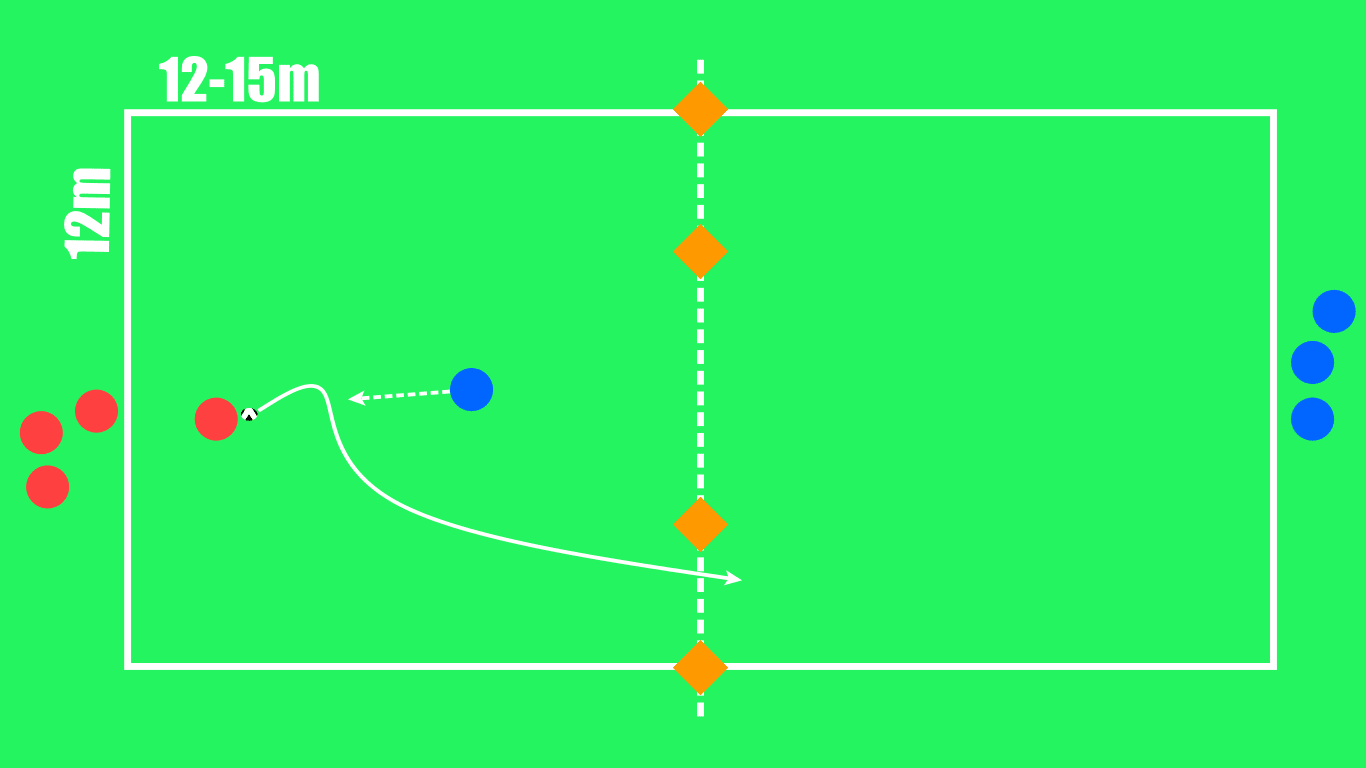
Whenever the player manages to pass through the opposition, his team gets a point and he goes in the second box, where the roles switch and he passes the ball to the opponent and now plays as a defender. The most important part of his after-possession activity is the counter-pressing. He doesn’t need to press always, the decision is on him, but it is encouraged for both sides to play on a very high-intensity level. The Blue that got outplayed exits the field and goes behind all the players on the closest sideline.
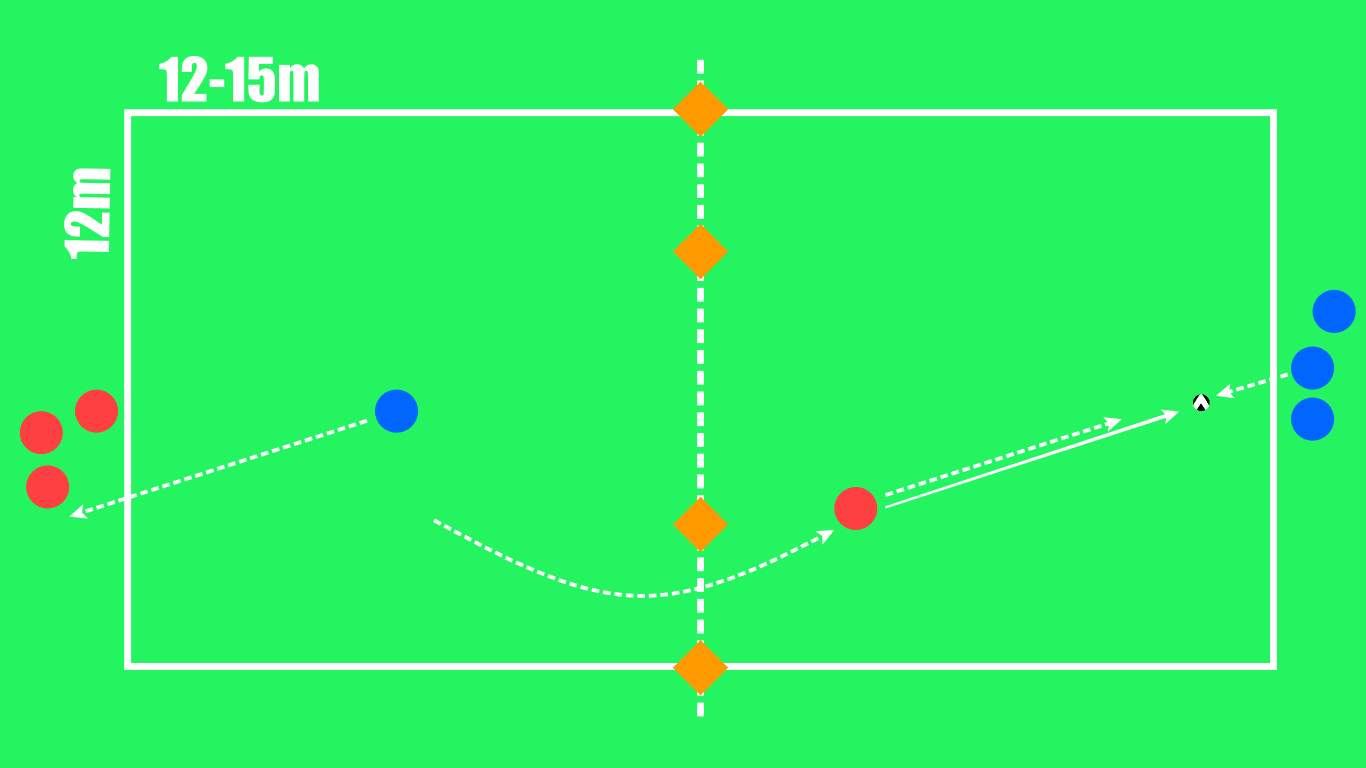
Above it is shown how the movements take place if the attacker succeeded in dribbling past the defender, and then passes the ball to the opposing team’s next player in line. If Red loses the ball in the first box, the defender passes it to his teammate on the opposite side, where the player who has lost the ball goes into defender’s role, as it is explained, but with no point for his side.
When it comes to variations in coaching in this exercise, you can restrict the number of seconds every player has with the ball in his feet, forcing them to move faster and make decisions quicker. This drill combines the teaching of skills from a lot of segments of the game, and it is not only applicable to the individual possession ones, but it mostly helps your players get better in the face to face possession. They need to accommodate themselves to situations where high-intense pressure is coming from their front side and they have very little time and space to make a decision, so this drill could help them become more confident and more prepared for in-game setups.
Three-zone 1v1s (with finishing)
The last drill we are going to talk about in this coaching analysis is the most complex one and can be used in the main part of the practices. It requires not that big of a field – in order to get your players used to playing in small spaces – with the size of 6-8x20m that is divided into three areas vertically.
Once again, the game is played between two teams, and every area has two players inside of it, one Red and one Blue. On the opposite sides of the box, there are two bounce players (which will later become/be changed for goalkeepers) who are the play-openers and final targets for both sides.
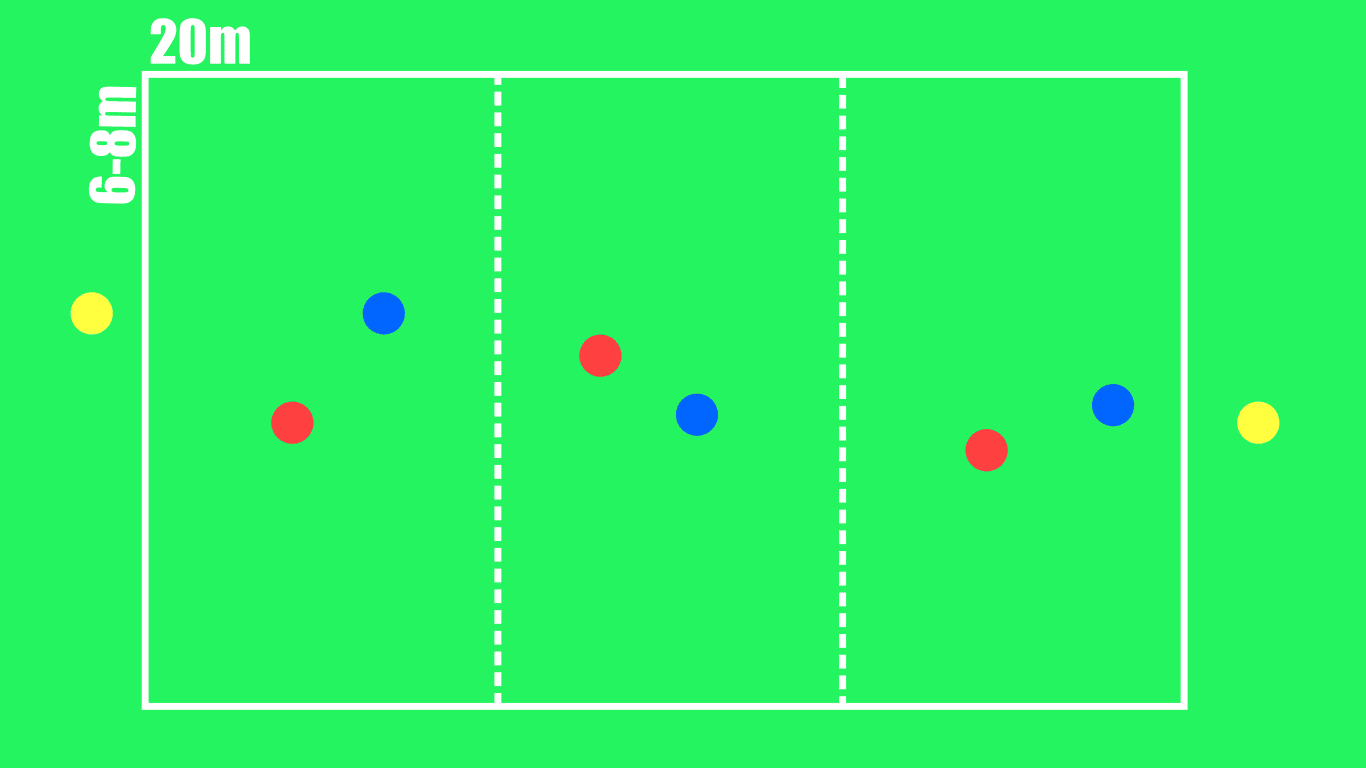
In the picture, we can see the initial setting of the drill, as it is described in the previous paragraph. The game begins with bounce player passing the ball into the first area, where the Red player (attacker) has the task to pass the ball into the next zone to his teammate, whilst being pressurized by the Blue. In order to do so, he’ll need to create space for himself – maybe dribbling, maybe just screening the ball and finding the open pass lane, it’s up to him.
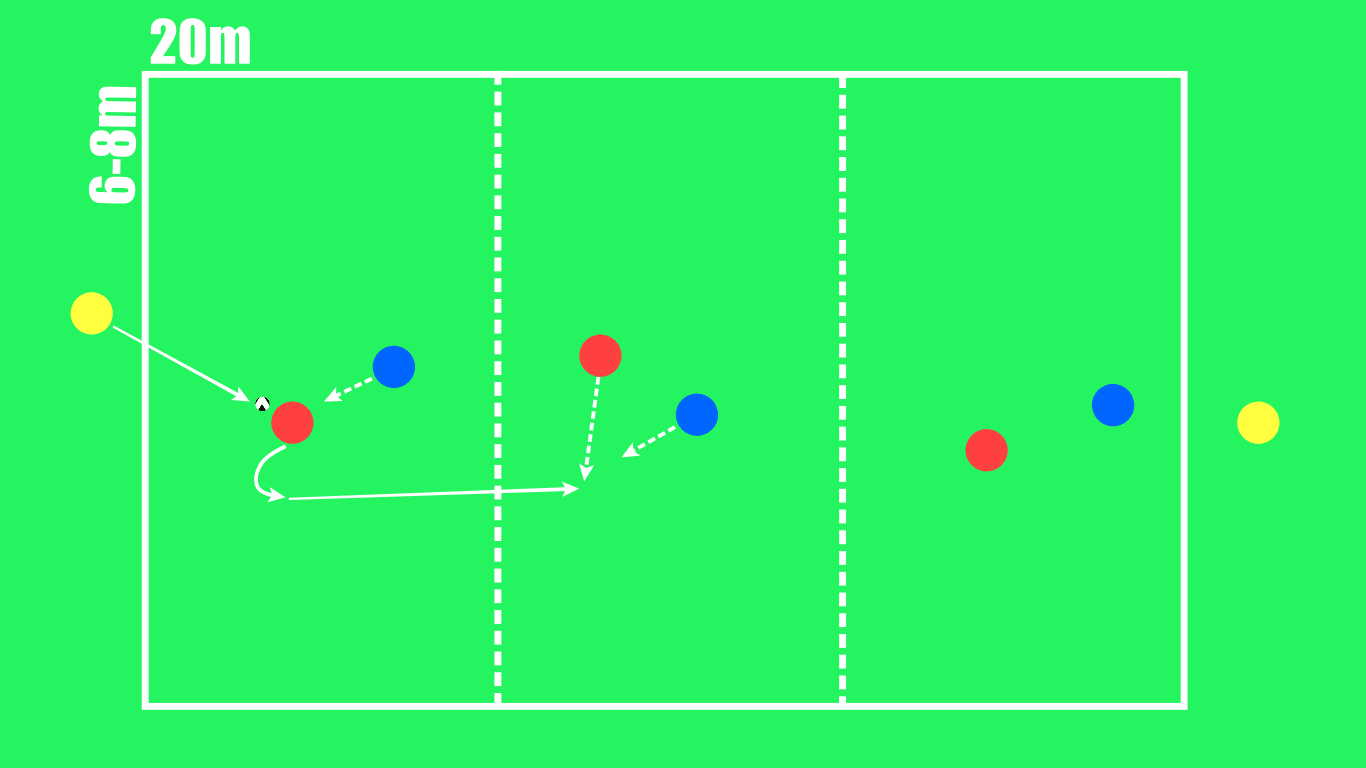
The player in the second area has the same goal of finding his teammate in the next one, with the defender playing in the same role as his teammate, but in his own zone. The last Red player has the task to pass the ball to the closer bounce player, and once he does it his team gets the point. If the Blues manage to win the ball in any of the zones, the roles switch, and they need to pursue going towards the opposite side bounce player in the same manner their opponents do.
If you see your players struggle, at first you can give them a return-pass option, where they can pass in the previous zone if they can’t find forward option, but it is not recommended to do it all the time so you should implement it shortly.
It is important to point out that you should encourage the defenders from eg. the second zone not to intercept passes if the player from the first manages to create space for the pass. Later on, you can let them be free in decision-making inside their own zone, but keep in mind that if they don’t succeed in intercepting, the player will break open and will have an easy task, which can result with you punishing them in some way. You should place your players in a way that defenders plays in the side zones against attackers, and midfielders are opposed in the central one, so they get the feeling of real-game positioning.
After the initial setup, you can mix things up by adding goals and goalkeepers to both ends of the small pitch. The tasks remain the same for both teams, and for every player individually in his own area, but with the addition of finishing from the attackers in the side areas. You should encourage all the players to move constantly so they could open themselves up as an option for their teammates, and it is also important to point out that the pass can’t be played from the first zone to the third.
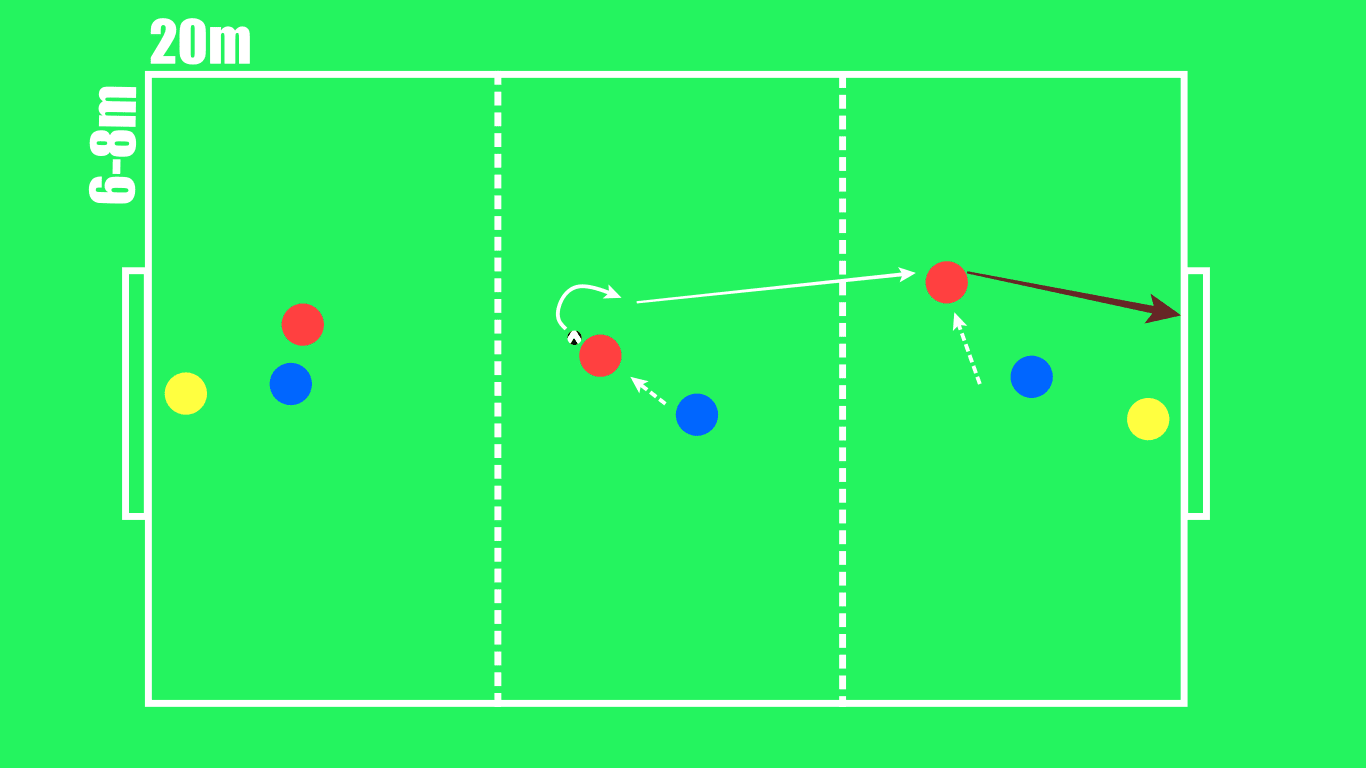
One more time, you have a mixture of on-the-ball security, movement of players, creating space for themselves and finally finishing in attacking part of the game, and communication, defensive decisions and pressing in defence, so it can help your team become more complete in a bunch of game segments.
Conclusion
On-ball security is probably one of the most important things in modern football, as spaces get narrower and narrower all the time, and players have less and less time for making the right decisions. Focusing on the individual possession abilities helps coaches influence both players’ technique and their mindset, building on on their decision-making and busting their self-esteem.
Individual possession is a key basis for possession-oriented tactics and needs to be taught with great attention if you want to complete your players’ skill sets. The idea of this concept is based on the art of getting, retaining and moving the ball so it unites a lot of factors that influence those parts of the game.
In this analysis, we tried to bring to you four drills that could be very useful when it comes to coaching this segment of the play. All of the drills are closely related to all the other phases of football that are of the greatest importance for creating unique possessional gameplan.
The whole concept can be very touchy, but with the correct attitude when coaching, can make a huge difference for your team, and can bring you to a whole new level.





Comments